Of lists, listing and listers: how many bird species in Senegal?
I have a bit of a confession to make. I’m a bit of an obsessive lister, always counting and collecting birds, new ones if at all possible. Or rare ones. I have a Life List, a Senegal List, Africa, Western Palearctic, a Technopole list. A list of colour-ring recoveries. And so on. Maybe not as far as keeping year lists or garden lists or self-found lists or lists of birds seen while writing up blog posts, but still I’m pretty much counting species all the time. I won’t go through great lengths to “tick” new birds and I don’t take the whole listing thing too seriously, neither will I keep track of my buck-per-bird expenditure rates (yes, it seems that some birders calculate this), but still… lots of obsessive listing.
I’m sure that some of our readers will recognise this – do we need group therapy? Maybe it’s just human (male?) nature, to be collecting and classifying things. Some of these lists may actually be quite useful especially when covering little-known regions as I sometimes get the chance to do on my work trips (think South Sudan, Somaliland, Burundi…), but for the most part they’re just my own little checklists sitting in an old Access database… time to upgrade, right?
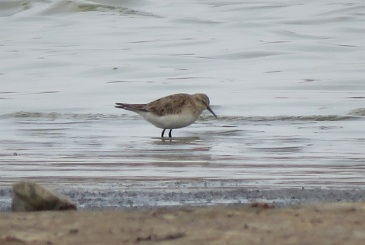
Baird’s Sandpiper / Bécasseau de Baird, Technopole – Senegal’s second record (and first documented) and a personal lifer
Luckily there’s still lots of new species to be counted, we’re not quite done yet – I’ve only seen less than a quarter of the world’s birds, mostly in Africa (ca. 1,370 species, Wilson’s Indigobird a couple of weeks ago near Lac Togo being the most recent addition), so there are still many new ones to discover.
By now, my Senegal list stands at about 495 species, after three and a half years of pretty active birding in the country. But how “good” is 495? How many species have been reliably recorded in Senegal? This may be an easy question, but the answer is certainly not so straightforward. First of all, what taxonomic reference to follow? Depending on which reference one uses, certain subspecies are elevated to species rank while others are not, and with current tendencies to split species it can be hard to keep up with the understandably dynamic nature of bird taxonomy.
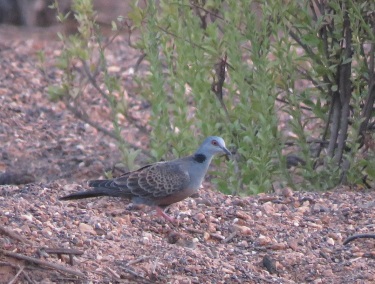
Adamawa Turtle Dove / Tourterelle de l’Adamoua, one of Senegal’s “specials” that can reliably be seen in the south-east
Several years of “service” in the Swiss national rare bird committee and a French regional records committee taught me a bit of discipline in keeping count of records and numbers for rare or scarce species, in ensuring appropriate documentation, in reassessing status of vagrants and scarce migrants, keeping track of changes in taxonomy and advances in identification criteria, and so on. And then there’s the status categories: “A” (species occurs naturally in the wild, seen at least once in modern ornithological history, eg. since 1950), “B” (same as A but not recorded since the cut-off year), “C” (introduced exotic species that have established autonomous breeding populations), “D” (the dreaded uncertain origin category), and finally “E” (escapes). Only species that are in the A, B or C categories are part of a country’s national list. In Senegal, the only established exotic species appears to be House Sparrow (unless Eurasian Collared Dove is also introduced or escaped, though this is far from certain; wild Rock Doves apparently still exist in the Kédougou escarpments).
So, in order to answer our question of the number of species occurring in Senegal, let’s start by identifying an appropriate taxonomic reference. The IOC (International Ornithological Committee) is nowadays usually considered the standard authority, being followed by many countries and authors. The Handbook of the Birds of the World (HBW) is another reference, I guess a bit more progressive than IOC, and was adopted by BirdLife and the IUCN. I won’t go into reviewing the differences between these and other lists such as Howard & Moore or Sibley, though we should mention that the African Bird Club follows IOC which as such should be an obvious choice here. Unfortunately, the ABC is not very good at remaining up-to-date to the extent that the current version dates back to 2010 – and at the time of writing, the page to download country checklists was non functional… The ABC now also has new “Dowsett country lists” which are largely based on the more conservative Howard & Moore taxonomy. More than anyone else, the Dowsetts are of course a major reference in their own right when it comes to African birds, and it would be great to have up-to-date checklists for each country. To make matters more complex, the ABC also links to checklists by their “partner” iGoTerra; unfortunately, their Senegal list is highly unreliable as it contains about a dozen species that have never been recorded in Senegal as well as several obvious missing species… and I assume that it’s the same for other countries. Really surprising (and disappointing) that the ABC endorses these lists. Similarly, other country checklists, e.g. the Avibase list, contain several serious errors and should be avoided. As such, we hope that the Senegal list that we’re making available here will be of use to local and visiting birders alike.
Either way, we settled on the IOC list – the choice of which can of course be debated, but it seems to make sense given that ABC is following it and that there is no proper reference committee for Africa (such as the AERC for Europe, though they’re not quite as authoritative as they ought to be, with many national committees following different standards). Anyway… let’s move on.
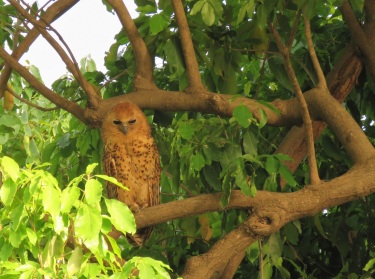
Pel’s Fishing Owl / Chouette pecheuse de Pel – one of the most recent additions to my own Senegal list, and a much anticipated lifer.
So, I took the African Bird Club country list for Senegal as a starting point, and updated it as per the latest IOC version. As our regular readers will surely know, quite a few species have been added to the national list in recent years, so these were of course included in the list. Several species on the ABC list are marked as uncertain, since at the time no proper documentation existed, such as Blue-throated Roller and Black-and-white Mannikin. I’ve removed those that seem unlikely, as well as Tropical Boubou which is yet to be confirmed (and I replaced Red-fronted Warbler, which was included in error, by Cricket Warbler). I’ve added Vieillot’s Black Weaver based on the account that Lesson described this species in 1840 based on a specimen from Casamance (it’s on the Gambian list, but not on the ABC list for Senegal). Here again, in the absence of a national or regional rare birds committee, these are personal choices and I’d be happy to revise these if there’s a good case to do so.
Below are the new species seen in the last 12 years, in chronological order. Those marked with a * were formally documented, typically through publications in the ABC Bulletin or in Malimbus; records with a ° symbol await publication or will be written up shortly:
- Western Sandpiper (15.1.07, Langue de Barbarie, Saint-Louis; N. Borrow et al.)
- Black Guillemot* (11.10.08, Ngor, Dakar; Crouzier et al.)
- Lesser Jacana (29.07.09, at a reservoir near Kédougou; ABC Recent Reports)
- Common Crane (22-25.03.10, Djoudj NP; ABC Recent Reports)
- Narina Trogon* (13.4.10, Dindéfélo, Kédougou; Aransay et al. 2012)
- Red Kite (23.2.12, Toubacouta, Fatick; ABC Recent Reports)
- Pacific Golden Plover* (10.5.12, Delta du Saloum, Fatick; Cavaillès et al.)
- Short-billed Dowitcher* (4.10.12, Gandiol, Saint-Louis; A. Hiley)
- Eurasian Sparrowhawk (27.01.14, Tiougoune/Lompoul-sur-Mer, Thiès; J. Wright et al.)
- Mountain Wagtail* (6.3.15, Dindéfélo, Kédougou; Pacheco et al. 2017)
- Eyebrowed Thrush* (10.12.15 Gandiol, Saint-Louis; R. Benjumea & B. Pérez 2016)
- Freckled Nightjar* (21.3.16 Dindéfélo, Kédougou; J.-Y. Blanc et al. 2018)
- Eurasian Collared Dove° (May 2016, Dakar; BP)
- Red-footed Booby° (16.10.16, Dakar, N. Moran et al.)
- Magnificent Frigatebird* (29-30.4.17, Iles de la Madeleine, Dakar; M. Lecoq & BP; G. Caucanas; Piot & Lecoq 2018 – link to ABC note forthcoming)
- Meadow Pipit* (1.1.18, Yène-Tode, Dakar; Piot 2018)
- Horus Swift° (5-6.1.18, Gamadji Sare, Podor; F. Bacuez, BP, F. Verroens)
- Brown-backed Honeybird° (21.1.18 Dindéfélo, Kédougou; G. Caucanas et al.)
On average, that’s just one or two additions per year – though note how 2012, 2016 as well as 2018, only half-way through, already stand out with no less than three new species. Also note how four out of these 18 records were also new to sub-Saharan Africa or even the African continent as a whole: Western Sandpiper, Short-billed Dowitcher, Black Guillemot, Eyebrowed Thrush. The records of Eurasian Collared Dove and Horus Swift, both possibly/probably breeding, constitute major range extensions in West Africa. The fact that another four of the above records are from the Dindéfélo area is also quite remarkable: it just shows how a previously largely ignored border area harbours several species that just creep into the country. Dakar, being relatively well watched in recent years, also stands out as a national “hotspot”, as is the Gandiol/Langue de Barbarie area to a lesser extent.
Add to this list the Canary Islands endemic Plain Swift, which thanks to geolocators was recently shown to transit through Senegal on its way to the newly discovered wintering grounds in Sierra Leone, Liberia and Guinea (Norton et al. 2018) – a nice example of modern technology solving one of the many remaining mysteries in the field of migration. Eleonora’s Falcon is another species that was confrmed to occur thanks to satellite tracking programs (Gschweng et al. 2008) but that is yet to be seen in natura.
Then there are two special cases, both of hybrids: a Greater x Lesser Spotted Eagle, that was GPS-tracked from its Central European breeding grounds into Mauritania, Senegal and Gambia; neither of the parents have been confirmed from Senegal as “pure” birds, but does this mean that this bird somehow needs to make it to the national list? To a lesser extent, the probable Woodchat x Red-backed Shrike seen last year is also an interesting case since the latter parent species has never been recorded in Senegal, though there are records from nearby Mauritania. Logically, hybrids should not be included on the national list, but I’d be happy to be convinced otherwise (in this specific case though, we cannot be 100% that the second parent of the hybrid shrike was indeed a Red-backed Shrike).
So now for the list: with the recent additions, and following the latest IOC taxonomy, we end up with at least 671 species. The full list is available HERE as a handy Google spreadsheet – of course it’s work in progress and I’d be happy to receive contributions. You’re more than welcome to download the list as an Excel file and use it as a checklist for the country. I did include a small number of species for which there are unconfirmed older records but that are likely to be present; these are marked with a ? in the list, and if confirmed would bring the total to 676 species. One of these is likely extinct in the wild by now: Common Ostrich, marked with an “E” (and Secretarybird probably shares the same fate though could still show up as a wanderer). Vagrants are listed as “V” in the list; for some of these – e.g. Little Gull – it’s not quite clear whether they should be considered as true vagrants or whether they are merely rare migrants that do in fact make it to Senegal on a more or less regular basis.
For those who tend to prefer the HBW/BirdLife taxonomy, the Senegal list should be at least 664 species – quite surprisingly this is quite a few species less than the IOC list, due to several splits that aren’t recognised by HBW (Boyd’s & Barolo Shearwaters are treated as part of Audubon’s Shearwater, White-breasted Cormorant is a ssp. of Great Cormorant, Yellow-billed Kite is rather suprisingly considered conspecific with Black Kite, Barbay Falcon part of Peregrine Falcon, African Reed Warbler a ssp. of Eurasian Reed Warber, and Atlas Flycatcher a ssp. of Pied Flycatcher). The only additional species is Seebohm’s Wheatear which surprisingly is not recognised by IOC, despite it being very distinctive from Northern Wheatear. Other splits do not directly affect the number of species on the Senegal list, though names may differ (e.g. Black-faced Firefinch is now known as Vinaceous Firefinch Lagnosticta vinacea, endemic to West Africa). When I find the time, I’ll also include a link to the HBW country checklist.
There are probably a few other species missing from the list, as not everyone goes through the effort of writing up notes or publishing pictures of potential first records. For instance, what would be the first record of Cinereous Vulture was only just recently uploaded to eBird and while it certainly seems like a credible observation, I’m awaiting further details from the observers. Likewise, there’s only one formally published record of Citrine Wagtail, but I found a reference to another observation that pre-dates the 1999 Technopole bird, which was mentioned along with a succinct (but in my view sufficient) description in the waterbird expedition report by Schepers and colleagues (27.1.97 at Djiffer, Saloum), and found out recently that a British tour operator that regularly visits Senegal has a few records of the species from Nianing. Once again, a real shame that the commercial birding companies rarely contribute to our knowledge of the areas that they visit. Corrections are more than welcome of course.
What will be the next species to be added to the country list? One can surely make a few predictions in terms of what species are likely to be added in the future – think various American vagrants with Ring-necked Duck and White-rumped Sandpiper being the most obvious candidates (and why not Wilson’s Phalarope or Solitary Sandpiper, or a Forster’s Tern or maybe even a Stilt Sandpiper), tropical seabirds such as Swinhoe’s Storm Petrel, Fea’s and Black-capped Petrels or Masked Booby, various desert passerines (Dunn’s Lark in particular should be sought for in the far north, White-crowned Wheatear is also a good possibility in winter), songbirds from northern Europe and Siberia such as Richard’s and Olive-backed Pipits or even Little Bunting, all of which have been reported from Mauritania. The lists goes on and on really – lots of potential to find new stuff!
Key areas to search for northern and American vagrants are of course the coastal wetlands, while the northern border regions should be targeted for winter vagrants and desert species. Finding new seabirds will likely require pelagic trips and a decent amount of luck¹ – and it’s likely that seabird monitoring programs that use satellite tracking will turn up some new species in Senegalese waters. For those lucky to go out birding in Casamance, chances are that Turati’s Boubou and Preuss’s Cliff Swallow are already established in a few localities and that they are just waiting to be discovered. Quailfinch Indigobird may well occur but apparently remains to be confirmed. And for those making it to the far south-east, why not search for Rock Pratincole which should occur at least occasionally along the Gambia river (or even along the Falémé), or try for low-density species that occur not too far out in Mali or Guinea of the likes of West African Seedeater and Cabani’s Bunting, and that may well just creep over the border into Senegal.
And then there are of course those species that one may expect the least, such as our Horus Swifts earlier this year – an incredible range extension (if confirmed to be regular) of some 1,600 km at least. Or Damara Tern, known from a single recent record from Mauritania (in 2006, Isenmann & Benmergui 2018). Only time will tell – what’s clear is that there’s still lots to discover.
Now, time to get out there and find new birds. And keep listing.
Bram, with useful contributions by Simon and Frédéric – merci à eux!
¹ and chum.
15 responses to “Of lists, listing and listers: how many bird species in Senegal?”
Trackbacks / Pingbacks
- - July 31, 2018
- - January 4, 2019
- - February 7, 2019
- - February 28, 2019
- - August 16, 2019
- - January 19, 2020
- - March 27, 2020


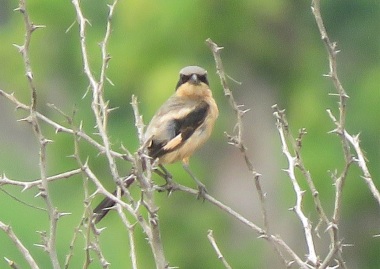
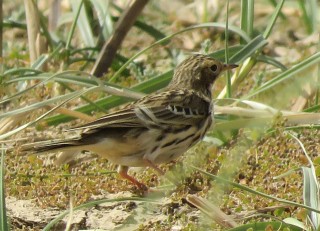
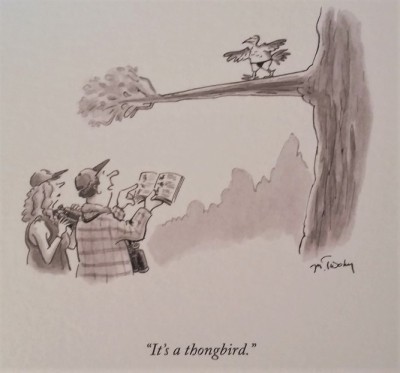


































































































































































































Ah ah ! I’m like that too ! I think it’s not very serious, don’t worry !
I have 987 species on my world bird list and I started four years ago… but I haven’t Senegal list yet ! 🙂
You are more than welcome to come and visit – as you can see, there are lots of great birds (and much more!) to be found in Senegal.
Thanks Bram ! 🙂
Very interesting (and useful) post. A list of the birds recorded at Dindefelo (to my knowledge) can be downloaded from https://www.janegoodallsenegal.org/research. I agree that commercial trips could contribute to improve bird inventories in certain areas. By the way, I was told by Joaquin Sanz-Zuasti, a Spanish birder formerly working for the Senegalese Park Authority, that he could confirm the current presence of Ostrich in the Ferlo.
Hi José María – thanks a lot for your comment. It would be really great to receive more details on the occurrence of Ostrich in the Ferlo!
As for Dindefelo, thanks also for the link. I had a quick look and will send you some additions as there are at least 5-6 species that are missing and that were seen at the end of last year or during our visit in February (e.g. Western Olivaceous Warbler, Oriole Warbler, Marsh Harrier and a few others).
Thanks again Bram. As for the ostrich, Joaquin Sanz-Zuasti was working for the DNP until december 2012, when his financial support ended. He told me that he had visited Ferlo in 2011 and 2012 and could confirm the presence of ostrich there. But he didn’t tell me more details on that. I think he is now living in Spain, but still visits Dakar regularly, I’ve written him, but don’t know if he will answer… Regards
Nice post Bram! I heard the same rumour of Ostrich as Jose back in 2012, but never managed to meet with Joaquin before he left, so it would be great if Jose found him.
For the next new species, I will bet (and give you an identification challenge!) on semi-palmated plover; lots of records from the Azores http://www.birdingetc.com/search?q=overlooked+but+over+here where I think it is the commonest american wader and a few from the Cape Verde. Paul.
Thanks Paul! Yes Semipalmated Plover is definitely a good candidate, just need to pick it out from the CRPs…